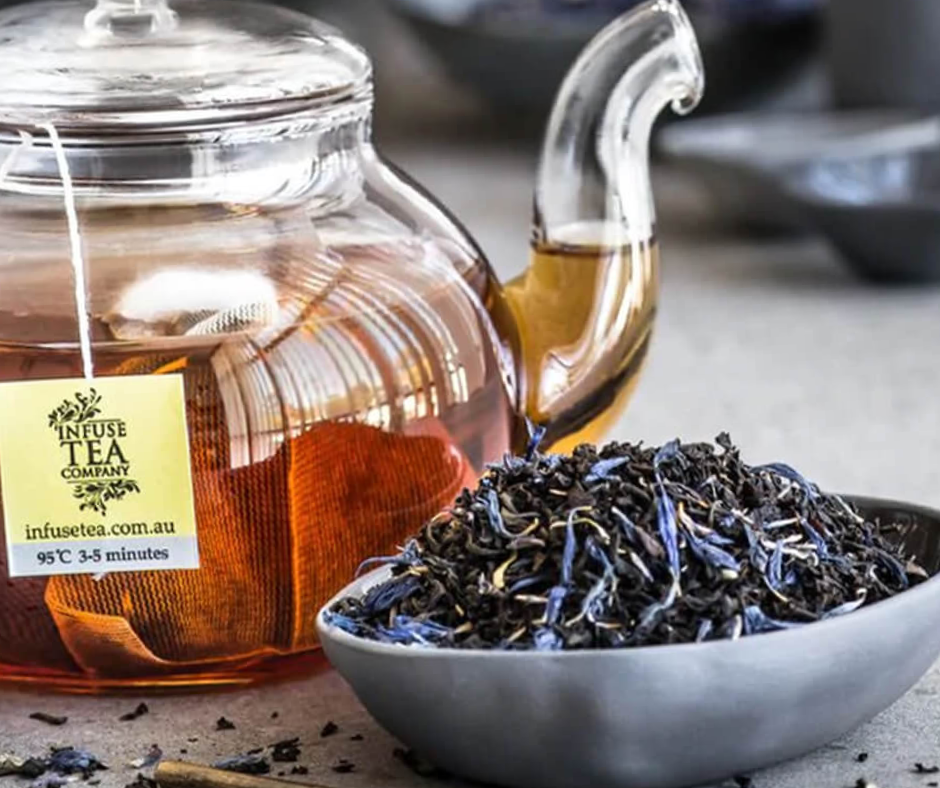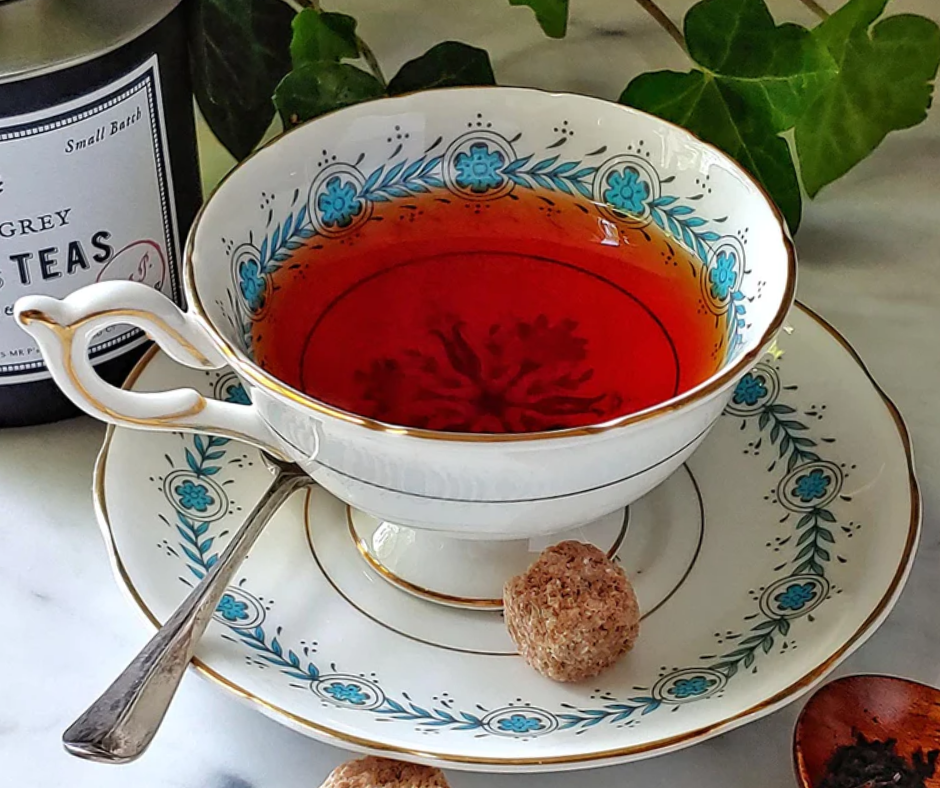Introduction
You’ve probably heard of Earl Grey tea if you’re a tea lover. It’s a classic tea flavor that is enjoyed by many worldwide. But have you ever wondered how much caffeine is in Earl Grey tea? The amount of caffeine in Earl Grey tea can vary depending on various factors. This article will explore Earl Grey tea’s caffeine content and how it can affect your health.
Overview Of Earl Grey Tea And Caffeine Content
Earl Grey tea is a blended tea flavored with bergamot oil, a fragrant and citrusy oil extracted from the rind of bergamot oranges. This type of tea is known for its delicate and light flavors, making it a popular option for those who want a less bold tea taste.
Regarding caffeine content, the amount of caffeine in Earl Grey tea can vary depending on the blend and the environmental factors affecting the tea leaves harvest. However, on average, a cup of Earl Grey tea contains about 47mg of caffeine, which is lower than the caffeine content found in coffee.
But for those who are looking for an extra caffeine kick in their Earl Grey tea, there are options available. For example, Zest Tea’s Earl Grey tea contains 150mg of caffeine per cup, achieved by adding a tea extract to its tea leaves. However, higher caffeine content may not be suitable for those sensitive to caffeine or trying to reduce their caffeine intake.
Comparing Earl Grey tea’s caffeine content to other types of tea, such as green or black tea, the caffeine content in Earl Grey falls somewhere in the middle. On average, a cup of green tea contains about 30mg of caffeine, while a cup of black tea contains about 60mg.
In conclusion, Earl Grey tea can be a great option for lovers looking for a light and delicate tea flavor. However, it’s essential to keep in mind the caffeine in Earl Grey tea, especially if you’re sensitive to caffeine or trying to limit your caffeine intake. Knowing the caffeine content can help you make more informed decisions about your tea choices.
What Is Earl Grey Tea?
Earl Grey tea is a black tea flavored with bergamot oil, a natural oil extracted from the rind of bergamot oranges. This tea is named after Charles Grey, the second Earl Grey and former Prime Minister of England.
The History And Origin Of Earl Grey Tea
The story goes that Earl Grey tea was created when a Chinese Mandarin gifted the tea blend to Earl Grey as a thank-you present. The tea was reportedly flavored with bergamot oil to mask the taste of lime present in the water on the Earl’s estate.
However, there is no concrete evidence to support this story. It is more likely that Earl Grey tea was created as a marketing ploy in the early 1800s to make a particular blend of tea more popular and desirable.
The Ingredients Used In Earl Grey Tea
The main ingredient in Earl Grey tea is black tea, but the bergamot oil gives it its signature flavor and aroma. Some tea manufacturers add spices and herbs, such as lavender, vanilla, and cornflower, to their Earl Grey blends.
The caffeine in Earl Grey tea can vary depending on the blend and brewing method. On average, a cup of Earl Grey tea contains about 47mg of caffeine, making it a suitable option for those who wish to consume less caffeine than what’s found in coffee.
In conclusion, Earl Grey tea is a classic tea flavor loved by many. The tea’s caffeine content falls between green and black tea and can vary depending on the blend and brewing method. Knowing the factors contributing to Earl Grey tea’s caffeine content can help individuals make more informed decisions when selecting beverages that fit their dietary needs and preferences.
Caffeine In Tea
Understanding Caffeine Content In Tea
Tea is a popular beverage enjoyed by millions of people around the world. It comes in many varieties, such as black, green, oolong, and white tea. One of the main components of tea is caffeine, a natural stimulant that can provide an energy boost.
The caffeine content in tea can vary depending on several factors, including the tea type, the water temperature, and the brewing time. Black tea, for example, tends to have higher caffeine content than other types of tea. The longer you steep your tea, the more caffeine it will contain.
Comparing Caffeine Content In Earl Grey With Other Tea Types
When it comes to caffeine content, Earl Grey tea falls somewhere in between black and green tea. On average, a cup of Earl Grey tea contains about 47mg of caffeine per 8-ounce serving. In comparison, a cup of black tea typically contains between 40-60mg of caffeine, while a cup of green tea contains about 25mg.
It’s also important to note that caffeine content can vary depending on the brand and brewing method of the tea. Additionally, some tea manufacturers may add extra caffeine to their blends, so it’s always a good idea to check the label if you’re trying to monitor your caffeine intake.
In conclusion, if you’re looking for a tea that provides a nice energy boost without the high caffeine content of coffee, Earl Grey tea is a great choice. Its delicate and light flavors make it a popular beverage, while its moderate caffeine content makes it a good option for those who want to limit caffeine consumption. Always remember to pay attention to brewing time and brand when determining the caffeine content of your tea.
Caffeine In Earl Grey Tea
Factors Influencing Caffeine In Earl Grey Tea
Earl Grey tea is a popular blend made by adding bergamot essential oil to black tea. The bergamot oil gives the tea its characteristic flavor and aroma. While Earl Grey tea contains less caffeine than coffee, its caffeine content can vary depending on several factors.
The amount of caffeine in Earl Grey tea can be influenced by the tea type used, the water temperature, and the brewing time. The longer the tea is steeped in hot water, the more caffeine it will contain. Higher-quality tea leaves also tend to have higher caffeine content than lower-quality tea leaves.
Typical Range Of Caffeine In Earl Grey Tea
On average, a cup of Earl Grey tea contains about 47mg of caffeine per 8-ounce serving. However, the amount of caffeine can vary depending on the brand and how the tea is brewed. Some Earl Grey tea blends may contain more caffeine than others.
Compared to other types of tea, Earl Grey falls in the middle regarding caffeine content. A cup of black tea typically contains between 40-60mg of caffeine, while a cup of green tea contains about 25mg. Compared to these types of tea, Earl Grey is a good option for those looking for a moderate energy boost.
In conclusion, Earl Grey tea is popular for its unique flavor and moderate caffeine content. While its caffeine content may not be as high as coffee or other teas, those sensitive to caffeine should still consume it in moderation. By paying attention to brewing methods and brands, individuals can choose a version of this classic tea that suits their caffeine intake needs.
How Much Caffeine Is In Earl Grey Tea?
Many enjoy Earl Grey tea, a popular tea blend for its unique flavor and aroma. While Earl Grey tea contains caffeine, the amount can vary depending on several factors, such as brewing time, water temperature, and the tea used. In this article, we will explore the caffeine in Earl Grey tea and how it compares to other types of tea.
Quantifying The Amount Of Caffeine In A Cup Of Earl Grey Tea
On average, an 8-ounce cup of Earl Grey tea contains about 47mg of caffeine. However, this amount can vary depending on the brand of Earl Grey tea and how it is brewed. The longer the tea is steeped, the more caffeine it will contain. Additionally, higher-quality tea leaves tend to have a higher caffeine content.
Compared to coffee, Earl Grey tea has a significantly lower caffeine. A cup of coffee contains about 80mg of caffeine, while a cup of black tea typically contains 40-60mg.
Standardized Caffeine Measurements In Tea
The Tea and Herbal Association of Canada has developed a measurement called the Caffeine Equivalency Guide to standardize caffeine measurements in tea. According to this guide, an 8-ounce cup of Earl Grey tea contains between 20-50mg of caffeine, depending on the brand and how it is brewed.
Compared to other types of tea, Earl Grey falls in the middle regarding caffeine content. A cup of green tea contains about 25mg of caffeine, while a cup of matcha tea contains about 70mg of caffeine. Earl Grey tea is a good option for a moderate energy boost.
In conclusion, while Earl Grey tea does contain caffeine, the amount is significantly lower than coffee and falls in the middle range compared to other types of tea. Individuals can choose an Earl Grey tea that suits their caffeine intake needs by paying attention to brewing methods and brands.
Health Benefits Of Drinking Earl Grey Tea
Earl Grey tea is one of the most popular tea blends worldwide, known for its unique flavor and aroma. Apart from its taste, this tea has several health benefits, from enhancing mental alertness to keeping the heart healthy. This article will explore some of the health benefits of drinking Earl Grey tea.
Nutritional Value And Health Benefits Of Earl Grey Tea
Earl Grey tea is rich in antioxidants, such as flavonoids, that help protect the body from damage caused by free radicals. Additionally, Earl Grey contains vitamins and minerals, including vitamins B1, B2, and E, as well as potassium, calcium, and magnesium. These nutrients are essential to maintaining healthy body functions.
The Positive Effects Of Caffeine In Tea Consumption
One of Earl Grey tea’s main components is caffeine, an alkaloid that acts as a stimulant in the body. Caffeine stimulates the brain, increasing mental alertness and reducing fatigue. It also stimulates the nervous system, leading to increased physical performance.
Recent studies have also shown that caffeine can help reduce the risk of age-related cognitive decline and improve memory in older adults. Furthermore, caffeine has been linked to a reduced risk of developing Parkinson’s and Alzheimer’s diseases.
Some studies suggest that Earl Grey tea can also help lower blood pressure and cholesterol levels. These effects are attributed to the antioxidants present in the tea, along with its caffeine content. Earl Grey tea may also have anti-inflammatory and anti-cancer properties, but more research is needed to explore these potential benefits in greater depth.
In conclusion, Earl Grey tea has several health benefits, including its caffeine content and high concentration of antioxidants. Drinking Earl Grey tea in moderation can lead to increased mental alertness, reduced fatigue, and healthier heart and brain function. However, it is important to note that these benefits may vary depending on the brewing methods used and the tea brand consumed. Individuals are advised to consult their healthcare provider before adding Earl Grey tea to their daily routine as with any dietary supplement.
The Best Ways To Enjoy Earl Grey Tea With High Caffeine Content
Earl Grey tea is a popular tea blend worldwide, known for its distinct aroma and flavor. This blended tea has several health benefits, such as a high concentration of antioxidants and caffeine content. Here are some of the best ways to enjoy Earl Grey tea:
Preparing Tea To Maximize Caffeine Content
To maximize the caffeine in Earl Grey tea, it is recommended to use loose-leaf tea instead of tea bags. Loose leaves contain more caffeine since they have a higher surface area than tea bags. Also, it is essential to use boiling water to brew the tea since caffeine is highly soluble in boiling water.
Caffeine And Brewing Time
The brewing time also affects the caffeine in Earl Grey tea. The longer the tea is left to brew, the higher the caffeine content. Brewing the tea for 3-5 minutes is recommended to achieve the ideal caffeine concentration.
Regarding caffeine content, Earl Grey tea has a higher concentration than green tea, but lower than coffee. One cup of Earl Grey tea contains approximately 50-90 mg of caffeine, depending on the brewing method and the brand of tea used.
In conclusion, Earl Grey tea is an excellent option if you’re looking for a high-caffeine content beverage with a light and delicious flavor. It is essential to use loose-leaf tea, boiling water, and an optimal brewing time to make the most of its caffeine concentration. As with any dietary supplement, moderation is key, and individuals are advised to consult their healthcare provider before adding Earl Grey tea to their daily routine.
Caffeine Side Effects And How To Avoid Them
The Potential Side Effects Of Caffeine Consumption
Although caffeine has many health benefits, including increased alertness and concentration, too much can cause adverse side effects. Some of the potential side effects of caffeine consumption include:
- Insomnia or sleep disturbance: Consuming caffeine too close to bedtime can cause difficulty falling asleep or staying asleep through the night.
- Increased heart rate and blood pressure: Excessive caffeine intake can increase the heart rate and raise blood pressure, harming individuals with pre-existing cardiovascular conditions.
- Digestive problems: Caffeine can stimulate the production of stomach acid, which can cause abdominal discomfort, nausea, and diarrhea in some individuals.
- Anxiety and nervousness: High caffeine intake can lead to feelings of restlessness, nervousness, and anxiety in some people.
- Dehydration: Caffeine is a diuretic, which can increase urine production and lead to dehydration if not matched with adequate fluid intake.
Tips For Avoiding Side Effects Of Caffeine
Fortunately, there are several ways to avoid or minimize the side effects of caffeine consumption:
- Limit caffeine intake: Experts recommend consuming no more than 400 mg daily, equivalent to about four cups of coffee or eight cups of tea.
- Choose decaffeinated beverages: Opting for decaffeinated versions of coffee, tea, and other beverages can reduce caffeine intake without sacrificing flavor.
- Drink plenty of water: Staying hydrated can help prevent dehydration and reduce the potential digestive discomfort caused by caffeine.
- Avoid consuming caffeine close to bedtime: Cutting off caffeine consumption at least six hours before bedtime can help prevent disruption of sleep patterns.
In conclusion, while Earl Grey tea is a healthy beverage with many benefits, including antioxidants and caffeine, it’s essential to consume it in moderation to avoid potential side effects. By limiting caffeine intake, choosing decaffeinated options, drinking sufficient water, and avoiding caffeine consumption close to bedtime, individuals can continue enjoying all Earl Grey tea’s health benefits without experiencing any adverse side effects.
Conclusion
Summary Of Earl Grey Tea And Its Caffeine Content
Earl Grey tea is a blend of black tea with bergamot oil, creating a fragrant and flavorful tea that has become a popular choice worldwide. The Caffeine in Earl Grey Tea varies depending on several factors, such as the type of tea leaves used and environmental factors that affect the harvest. However, Earl Grey tea generally provides moderate caffeine, making it a good choice for an afternoon energy boost without causing sleep disturbances at night.
Final Thoughts On The Benefits And Drawbacks
While Earl Grey tea offers many potential benefits, including antioxidants and caffeine that can help boost energy and focus, it’s important to consume it in moderation to avoid potential side effects like insomnia, increased heart rate, digestive problems, anxiety, and dehydration. To minimize these side effects, individuals can limit their caffeine intake, choose decaffeinated options, drink plenty of water, and avoid consuming caffeine close to bedtime. Overall, Earl Grey tea can be a healthy and delicious addition to a well-balanced diet when consumed in moderation.
FAQ: Caffeine in Earl Grey Tea: Exploring the Boost
Q: What is Earl Grey Tea?
A: Earl Grey tea is a blended type of tea made from a combination of South Indian flowery orange pekoe black tea, bergamot flavor, and natural caffeine.
Q: What is the Caffeine in Earl Grey Tea?
A: Each cup of Zest Earl Grey tea contains about 150mg of caffeine, significantly higher than the average content in most other teas.
Q: Does Earl Grey tea have more caffeine than other types of tea?
A: Yes, Earl Grey tea generally has a higher caffeine content than most other teas due to the added natural caffeine extract used in the blending process.
Q: What are the benefits of drinking Earl Grey tea with higher caffeine content?
A: Earl Grey tea is a great option if you’re looking for an energy boost without sacrificing flavor. Earl Grey tea’s light and delicate flavors make it enjoyable to drink, while the higher caffeine content provides a strong burst of energy.
Q: Are the ingredients in Zest Earl Grey tea natural?
A: Yes, Zest Earl Grey tea only uses natural, non-GMO ingredients, including the South Indian flowery orange pekoe black tea, bergamot flavor, and natural caffeine extract.

Deb Carlson at Crosslake Coffee: Join Deb at Crosslake Coffee for a delightful blend of community, caffeine, and creativity. Discover the cozy ambiance and warm hospitality that make this local coffee shop a beloved gathering spot. From expertly crafted espresso drinks to mouthwatering pastries, Deb invites you to savor every sip and bite. Stay connected with the latest updates on specials, events, and live music performances by following Deb Carlson at Crosslake Coffee on social media. Embrace the vibrant online community and share your love for great coffee and good company with fellow enthusiasts. Don’t miss out on a moment of the Crosslake Coffee experience – connect with Deb on social media today.



